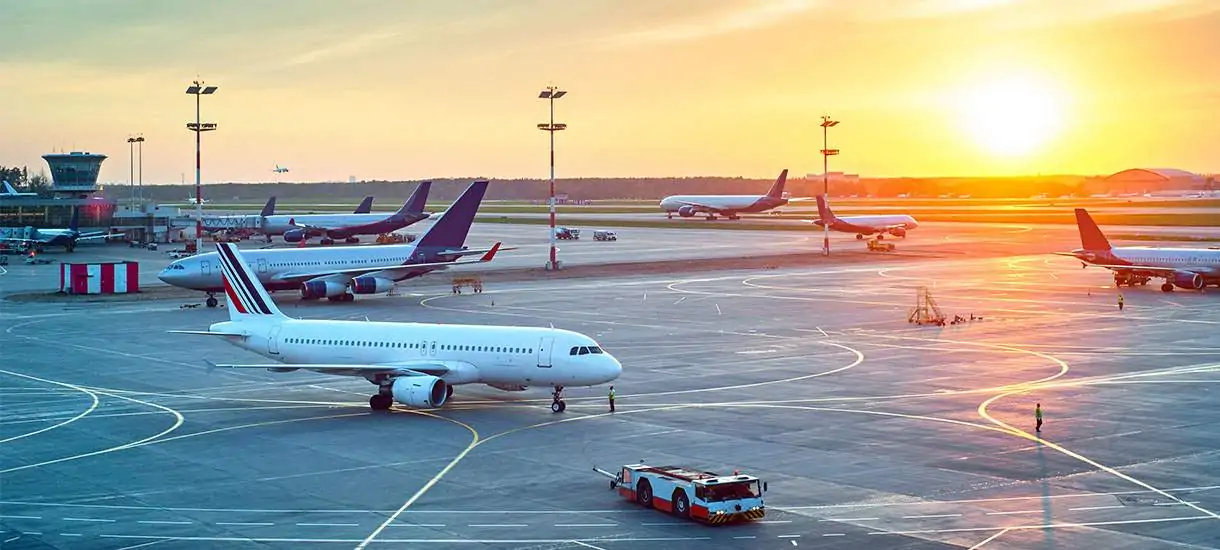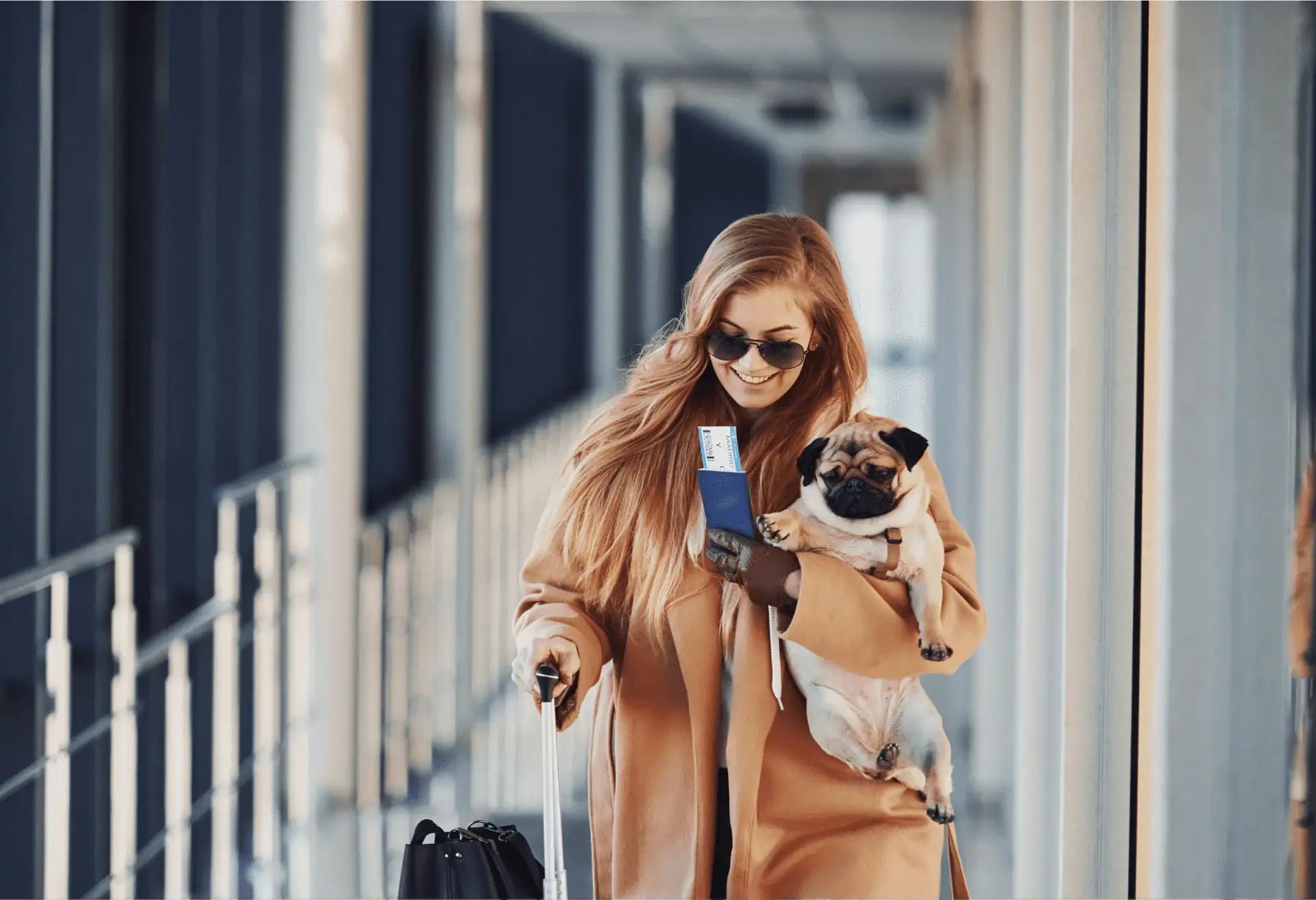Air travel can be stressful, especially if you don’t fly often. But when long lines, flight delays and overpriced extras threaten to suck the joy out of your airport experience, just take this frequent flier’s travel tips to heart. As a flight attendant, I’m always on the go, but there are some things the average flier may not be familiar with. Whether you’re looking for tips on packing light or troubleshooting in-flight ailments, believe me, I’ve been there.
From bringing your own booze to scoring an upgrade to what to do if you’re not feeling so hot in-flight, I’m here to help. Read on for insider tricks and tips and be on your way to having the best flight ever.
Picking a seat
The truth about free upgrades
Lugging your luggage
Dressing for your flight
Avoid getting ‘hangry’ in-flight
Hydrate, hydrate, hydrate
For when you’re not feeling so hot
Flying with kiddos
The power of good vibes
Picking a seat
While you can’t always control who your neighbours are, there are some factors you may want to consider when choosing your seat that could seriously impact your overall flight experience.
- Looking for a smoother ride? Sit in front — Much like riding a bus, it is always bumpier in the back of the plane. Turbulence is exponentially worse the smaller the aircraft is and the closer to the back you are. If you have a weak stomach or if bumps in the air make you nervous, you may want to pick a seat in the front half of the plane.
- Drinking a lot of water? Choose an aisle — Consider your own bodily functions. Maybe you make frequent visits to the washroom or have restless legs. Whatever the reason may be, if you’re going to be out of your seat more than once or twice during the flight, try to snag an aisle seat. This is especially important on overnight flights so that you don’t have to disturb sleeping seatmates. If you take restroom breaks infrequently, you may want to secure yourself a window seat so those antsy neighbours don’t disturb you.
- Trying to sleep? Skip sitting near the galley — Speaking of overnight flights, or evening flights in general, did you know that we’re supposed to keep the lights on in the galleys throughout the entire flight? If you’re planning to get some rest on your flight, take a look at the seating map and the locations of the galley areas on the plane. It’s likely they’ll be brighter and louder than other areas.
The truth about free upgrades
- Free upgrades are rare — The question on everybody’s mind: how does one procure a free upgrade? For a lot of airlines, giving these seats away simply isn’t allowed. Think for a moment about how you would feel if you spent an extra $50, $100 or more to ensure your comfort and extra space during the flight and then the flight attendants started moving people into the seats next to you for free. You’d probably wish you hadn’t paid the extra fee. You’d probably feel upset, and rightfully so. Of course, you can always try to be your sweetest self and ask a friendly-looking flight attendant for an upgrade, just don’t be surprised if he or she says no.
- One trick to try (if you don’t mind the gamble) — There is one dirty little trick that has been used time and time again, and while risky, often pays off. If you forgo choosing a seat in advance, you’ll be assigned one at the airport. Because most people, just like you, don’t want to pay an upgrade fee, it’s likely that the last seats available will be seats with extra leg room, often in the exit rows. The agents at the gate or ticketing counter will assign seats to customers, and if you didn’t select an upgrade they won’t charge you for one. The obvious risk here is that if the flight isn’t completely full you may be stuck with a middle seat, and there’s no guarantee you’ll be able to sit next to your travel companion. But if you’re flying solo, want free leg room and don’t mind a little risk, I’ve seen it work before.
Lugging your luggage
- Baggage policies are not universal — Baggage policies are something you should research before the day of your trip. They vary from airline to airline and if you’re travelling abroad they can be even more restrictive. Each airline has a page on their site outlining their size and weight limits for carry-ons and checked baggage, as well as a list of items that cannot fly. If your bags are on the borderline, you can use a tape measure and a bathroom scale to make sure they’re compliant. You don’t want to be scrambling to reorganize your luggage at the ticketing counter or get hit with steep oversize fees. I once had to pay to ship suitcases from Sydney to Bangkok and then back to the States for a cool $1,000 because the baggage policies of the two international carriers I was using had different size restrictions. A little research goes a long way. Most U.S. carriers allow for one carry-on like a rollaboard suitcase or duffel bag (max of 22 x 14 x 9 inches or 56 x 36 x 23 centimetres) and one smaller personal item (your purse, backpack, diaper bag, briefcase, etc.).
- Keep calm and carry-on — I have a carry-on only policy for most of my personal travel, especially since, as a flight attendant, I often fly stand-by. For one thing, I’m not guaranteed a seat and need to have my bag with me in case I don’t make it on a flight. And whether it’s because of four flights of stairs leading up to my Airbnb or no trunk space in my rental car, I seem to regret it every time I pack a large suitcase. This policy isn’t good for everyone. If you have kids, if you’re staying in one resort or vacation home for a week, if you’re visiting family and have plenty of space, then by all means, check that bag. If you’ll be in multiple destinations it just becomes impractical.
- Zip it — Pack your things in a bag with a zipper that fully closes. I have seen people board with overflowing open tote bags and watched helplessly as a rogue shoe toppled out of a beach bag and landed on an unassuming passenger’s head. It’s not the best way to start a flight. And, with contents of the overhead shifting in flight, you don’t want to be searching for items when everyone is trying to retrieve their belongings.
- Roll, roll, roll your clothes — When it comes to packing, I subscribe to the rolling method, wherein I roll all of my pants, shorts or skirts into tiny fabric burritos and stuff them, one on top of the other, into my bag. Socks (and hose if I’m at work) go inside my sneakers. The only thing I don’t roll is shirts and this is because I prefer them to be unwrinkled — but also prefer not to use an iron if I can help it. I lay all of my shirts one on top of the other (the most likely to wrinkle on the bottom of the pile and the ones I care least about like workout tanks on top). I gently fold the shirts all together, and the layers from the inner-most shirts prevent the outside ones from getting wrinkled. The best advice I can give about packing light is to downgrade the shoe selection. I can’t tell you how many times I’ve packed five or more pairs of shoes and ended up wearing the same two pairs every day.
- If all else fails, gate check — I’m a firm believer in carry-on only travel, but try not to over pack, as you’re responsible for lifting your own suitcase into the overhead bin. If you don’t feel like lugging your large bag around, talk to the gate agent. Many airlines will let you check your bag free of charge at the gate. Now there’s a weight off your shoulders.
Dressing for your flight
- Dress smart (and comfortable) — A fact well known by anyone who travels frequently is that airplane temperatures run on two settings: arctic chill or blazing inferno. The air conditioning often isn’t turned on until midway through the boarding process and it can be toasty at this point. Because of this, layers are the key to success. Because, as a flight attendant, I typically fly as a non-rev (non-revenue) passenger, the in-flight dress code is a bit more business casual than what’s expected of the average flyer. I opt for skinny pants, a cute but comfortable tank, a cardigan and/or blazer, and a cute scarf to add a touch of colour to my mostly neutral wardrobe. While the typical flier may dress down a bit more, when choosing your travel ensemble, opt for something comfortable but also presentable that you wouldn’t mind say grabbing a coffee or a drink with friends in. Skip anything too short or tight—you bloat in the air, especially after eating airplane snacks—and save the obscene tee shirts and pajamas for another occasion.
- Start off your flight on the right foot — When it comes to shoes, choose wisely, you’ll likely be taking them off during your security screening. Therefore, it’s smart to skip anything that involves a lot of effort in tying or untying, like lace-up boots. I fly business casual, so I never wear sneakers to fly, but it’s a great option if you’re able to do it. Not only will your feet be comfortable, but you’ll save a ton of room in your suitcase by wearing your more bulky footwear. Sandals aren’t great for air travel because having cold feet is miserable (and you’ll also have to walk through security barefoot), but if you’re going to wear open-toe shoes, throw a pair of warm socks in your carry-on to wear during the flight. When it comes to heels, opt for booties or a sensible pump in a comfortable height. If you can’t run to the gate to catch your flight or run down the aisle in the event of an emergency, then your shoes are not suitable for the airport. And one note to fliers from someone who has seen it all: entering an aircraft lavatory in socks or bare feet is never okay.
- Dealing with circulation issues — If you’re someone with poor circulation or just tend to run on the cool side, pack yourself a small travel blanket or a jacket you can throw on if you need to (using a jacket as a blanket also saves room in your luggage if you were planning on packing it). And speaking of circulation — compression hose or socks are a good idea if you are prone to swelling, at risk of blood clots or have poor circulation. Flight attendants often wear these under our uniforms to help with swelling legs, aching feet and, worst of all, blood clots which can form and worsen with constant air travel.
Avoid getting ‘hangry’ in-flight
Trying to eat healthy while travelling can be a challenge. Some airlines offer healthier fresh options like salads or cheese and fruit plates, but many only carry the basic packaged snacks chock full of sodium and sugar. Check your airline’s website to see if your flight will be offering fresh food or just snacks and be aware that if food is offered, the plane holds a limited quantity.
- Avoid getting ‘hangry ‘– Because I’m prone to embarrassingly loud stomach growls and becoming “hangry,” I play it safe and always pack something just in case. You never know when a line of traffic on the runway or a holding pattern before landing can turn your two-hour flight into three or more. Apples, bananas and almonds travel well for a quick snack mid-flight, but you’re allowed to bring whatever solid food you want from home. I’ve seen PB&J sandwiches (great for travelling with kids), homemade salads, chicken wings in foil and about every other food you can think of. If it isn’t practical to bring food from home, airports are getting better at providing healthy on-the-go options. Grab a Greek yogurt or a hummus and veggie pack to get in some healthy protein. But please, for the sake of everyone around you, skip the fish and chips. Bringing seafood on the plane (or other foods with strong smells) can lead to a lingering odour, which can make the flight unpleasant given the close quarters. No one wants to show up to their mid-day meeting smelling like your leftover tilapia, and for people who are prone to air sickness, the smell is especially offensive.
- BYO alcohol to save money — Keep in mind that anything you purchase in the airport or on an airplane is going to be charged at inflated prices. Alcohol is no exception, so you’ll be happy to know (when flying with certain airlines) you can drink your own alcohol on board. However, by law, this must be served to you by a flight attendant and only consumed in the air. Keep in mind, while it’s allowed by some airlines, there are rules to follow if you’re hoping to drink your own booze on board. The alcohol you carry on is subject to the same restrictions as other liquids (100ml or 3.4 oz. maximum packed in your clear, plastic bag for TSA screening and no more than 140 proof or 70% abv). Unfortunately, alcohol you purchase duty-free cannot be opened in flight. While you can bring it on board, a receipt must be shown and it must have a seal and proper carrying case provided by duty-free. Believe it or not, U.S. carriers are not allowed to transport intoxicated passengers, so keep this in mind before you hit up happy hour in the airport or order drinks during your flight. It’s never fun kicking people off the plane during boarding and it’s even less fun cutting you off when you’re drunk and asking for another at 30,000 feet. Always drink responsibly, whether flying or while feet planted firmly on the ground. Also note, while the FAA sets the rules on how to carry on alcohol, it’s up to the individual carrier whether or not they’ll serve you your own alcohol in flight, so be sure to check with the airline you’re flying with first. (Find more info on flying with alcohol here.)
Hydrate, hydrate, hydrate
- Drink up — The most important thing you can do to take care of yourself while flying is to drink lots and lots of water. The recycled oxygen in planes is super drying and full of germs. Staying hydrated will keep your immune system strong, your skin supple and help to counteract jet lag. If you plan on ordering something with caffeine or high sodium content, (that breakfast Bloody Mary, perhaps?) be sure to order water as well. Many airports now have water refilling stations so feel free to pack an empty water bottle to fill once you’ve cleared security. You can save that $5 for a fro-yo. This is especially important if you’re travelling on a red-eye flight. You’d be amazed at the number of people who faint on red-eyes and it is almost always due to lack of food or hydration.
- Moisturize on the fly — Flight attendants have to take special care to be hydrated and fresh. You’d be hard pressed to find a flight attendant who doesn’t carry hand or body lotion in his or her bag, and we absolutely always have some form of lip balm. A lot of flight attendants carry a facial mist to spritz intermittently throughout the work day to keep their face looking and feeling great. SPF is also super important for flight attendants, who are two times more likely than the general population to suffer from melanoma due to the strength of the UV rays at flying altitudes. Consider adopting these tips if you’re a frequent flyer.
For when you’re not feeling so hot
- We can help with that headache — In addition to life-saving emergency equipment, we have basic first-aid items like bandages and alcohol wipes, aspirin and antacids available if you’re in need during the flight. We also have a variety of remedies for an upset stomach (tonic water or ginger ale), feeling faint (orange juice, some cookies and an ice pack) and other common in-flight ailments. If you’re injured, ill or just feeling a little off, tell your flight attendants. We are here to help.
- Getting some Zzzz — We don’t carry sleep-aids on board, but we do sometimes have extra sleep masks on the aircraft. If you’re flying a red-eye or very long flight and are concerned about your ability to fall asleep on the plane, try bringing a Chamomile or bedtime tea bag and asking for hot water during beverage service. Or take five milligrams of melatonin, an herbal sleep aid available at any drug store. Skip the strong sleep meds and any medication you haven’t taken before. The altitude can increase side effects.
Flying with kiddos
- We love kids — Don’t pay attention to the passengers rolling their eyes, we love when babies fly with us. They’re adorable and often better behaved than the adults on board. Most flight attendants would be happy to hold the baby if you need to take a restroom break or just need a minute getting settled. And most pilots will be happy to let your little ones check out the cockpit. Just ask.
- In-flight tips — Flying is boring for kids, so make sure you have a colouring book, a tablet or some kind of interactive toy to keep them busy. Balls and other toys that roll aren’t a great idea. Babies often cry during take-off and landing because the pressure change hurts their ears. Giving them a bottle at this time will help to alleviate the pain. For older kids, any chewing or swallowing motions will help to do the same thing. Bring plenty of snacks, but try to limit the sugar content for your own sanity. And if one of your little ones has an allergy to nuts or pets just let us know before the flight.
- Bring a change of clothes (for yourself!) — Parents with babies or young children always bring a change of clothes for the kids but forget to bring one for themselves. I’ve seen many a mom exit the aircraft wearing a vomit-laden shirt. Kids are messy, pack accordingly.
- Kids flying solo — While you should check with the airline your child is flying directly (find more information and contact info here), airlines are typically very accommodating to kids flying on their own. We are quick to give them whatever they want or need to have a comfortable and happy flight — blankets, snack boxes, headphones. That said, policies vary by airline, so always make sure to pack them something to entertain themselves, as well as some snacks to keep them full. Be sure to let a gate attendant or airport employee know if your child has any dietary restrictions, allergies or is nervous about flying so we can make them as comfortable as we can. Parents should also bring a book or tablet for themselves in case of delays as they have to stay until the flight takes off and unaccompanied minors are usually boarded last.
The power of good vibes
- Make the best of any situation — Things will never go exactly according to plan in this industry. But don’t let a minor setback ruin your whole day. Flight delayed? Grab a beer and strike up a conversation with one of the other people stuck waiting. Call up your parents and have a nice overdue chat. No Wi-Fi on the plane? Great! That’s an excuse to ghost the productivity you’d been promising yourself and dive into the book you’ve been carrying around, or better yet, indulge in a guilt-free nap. Try to see the silver linings and you’ll have a much better experience.
- A little kindness goes a long way — The last little bit of advice for having the best flight ever is to bring your patience, empathy and kindness. Try to keep in mind that people fly for many different reasons. You may be going on vacation, but the seemingly grouchy person ahead of you could be flying out to attend a funeral. Approach your crew with kindness, and, if you feel so inclined, chocolate, and we will reciprocate tenfold. The bottom line is we’re all in the same boat here, trying to get from point A to point B safely. Pack your positivity and you will be well on your way to having the best flight ever.
Looking for a cheap flight? You could always start dating a flight attendant (the catch here is we will usually make you wait a year before adding you to our flight benefits). If you don’t feel like waiting, head to Cheapflights.ca to start your flight search.
Main image: istockphoto/encrier



